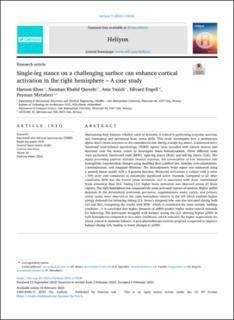| dc.description.abstract | Maintaining body balance, whether static or dynamic, is critical in performing everyday activities and developing and optimizing basic motor skills. This study investigates how a professional alpine skier’s brain activates on the contralateral side during a single-leg stance. Continuous-wave functional near-infrared spectroscopy (fNIRS) signals were recorded with sixteen sources and detectors over the motor cortex to investigate brain hemodynamics. Three different tasks were performed: barefooted walk (BFW), right-leg stance (RLS), and left-leg stance (LLS). The signal processing pipeline includes channel rejection, the conversation of raw intensities into hemoglobin concentration changes using modified Beer-Lambert law, baseline zero-adjustments, z-normalization, and temporal filtration. The hemodynamic brain signal was estimated using a general linear model with a 2-gamma function. Measured activations (-values) with -value < 0.05 were only considered as statistically significant active channels. Compared to all other conditions, BFW has the lowest brain activation. LLS is associated with more contralateral brain activation than RLS. During LLS, higher brain activation was observed across all brain regions. The right hemisphere has comparatively more activated regions-of-interest. Higher ΔHbO demands in the dorsolateral prefrontal, pre-motor, supplementary motor cortex, and primary motor cortex were observed in the right hemisphere relative to the left which explains higher energy demands for balancing during LLS. Broca’s temporal lobe was also activated during both LLS and RLS. Comparing the results with BFW– which is considered the most realistic walking condition–, it is concluded that higher demands of ΔHbO predict higher motor control demands for balancing. The participant struggled with balance during the LLS, showing higher ΔHbO in both hemispheres compared to two other conditions, which indicates the higher requirement for motor control to maintain balance. A post-physiotherapy exercise program is expected to improve balance during LLS, leading to fewer changes to ΔHbO. | en_US |

